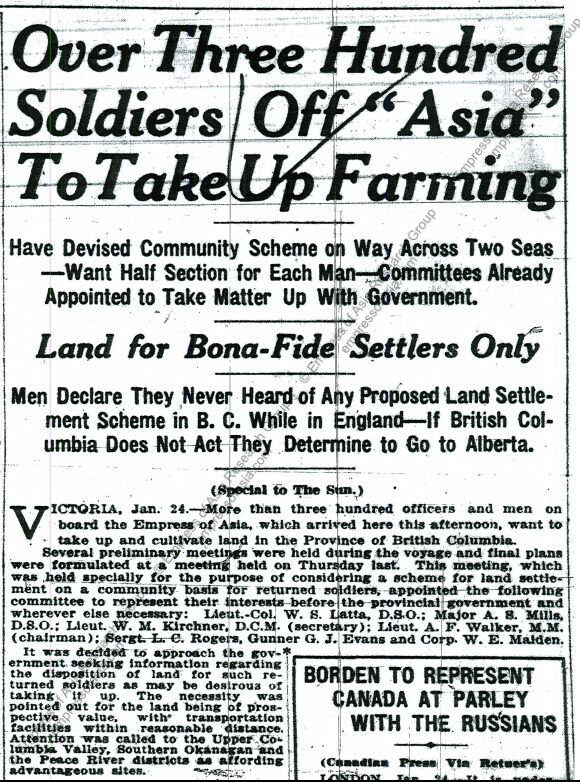With the Armistice of 1918, the EMPRESS OF ASIA was almost immediately enlisted to transport Canadian troops home. The ship sailed from Liverpool on January 2nd, 1919 with over 1,300 military personnel on board.
On the voyage several hundred veterans decided that upon arrival in British Columbia they would endeavor to settle together in a co-operative farming community. This group became known as the Asia Land Settlement Committee.

The EMPRESS OF ASIA reached Victoria on January 24th, 1919, and Vancouver the following day. Shortly after arriving in British Columbia, a delegation representing the Committee and including Lieutenant-Colonel W. S. Latta, Major Art Mills, Lieutenant W. H. Kirchner, and Sergeant L. C. Rogers met representatives of the Provincial Government and secured a pledge of assistance. On February 25th, 1919 Lieutenant W. H. Kirchner and Lieutenant A. F. Walker, representing the Committee, made another visit to the Provincial Government and then, in late March, visited the Federal Government at Ottawa and successfully lobbied for support for the co-operative community. While in Ottawa, Kirchner and Walker were able to allay the concerns of the Federal Government.
In April a site of 14,000 acres was selected for settlement in the Courtenay Valley of British Columbia on land that had been logged by the Canadian Western Lumber Company. The new settlement was named Merville. By early May of 1919 soldier settlers whose ranks now included not only men who had returned on the EMPRESS OF ASIA but other like minded soldiers as well, began to arrive and clear the land for farming and habitation. By September 1919 the new community reported a population that included 120 returned soldiers and their families.
Construction included a new school that was officially opened by the Prince of Wales who visited Merville on September 26, 1919.
The community faced many challenges. It was very difficult to clear the land. Large stumps remained from the earlier logging operations and they had to be removed using blasting powder, teams of horses, and steam driven equipment.
On July 6th, 1922 a forest fire that had been burning for some time in the region suddenly changed direction and fanned by a strong wind struck Merville. One fatality and several injuries were reported and the fire destroyed many homes and buildings as well as crops and livestock.
Relief committees were quickly formed to secure and provide aid and Premier Oliver of British Columbia visited Merville on July 9th, 1922 and pledged immediate assistance. Colonel Latta, Chairman of the Land Settlement Board, was sent to Merville to evaluate the situation and determine how to facilitate the return of settlers to their homes.
Although the community was rebuilt following the fire, other challenges remained that made farming in the Merville region of the Courtenay Valley a very difficult economic enterprise.
